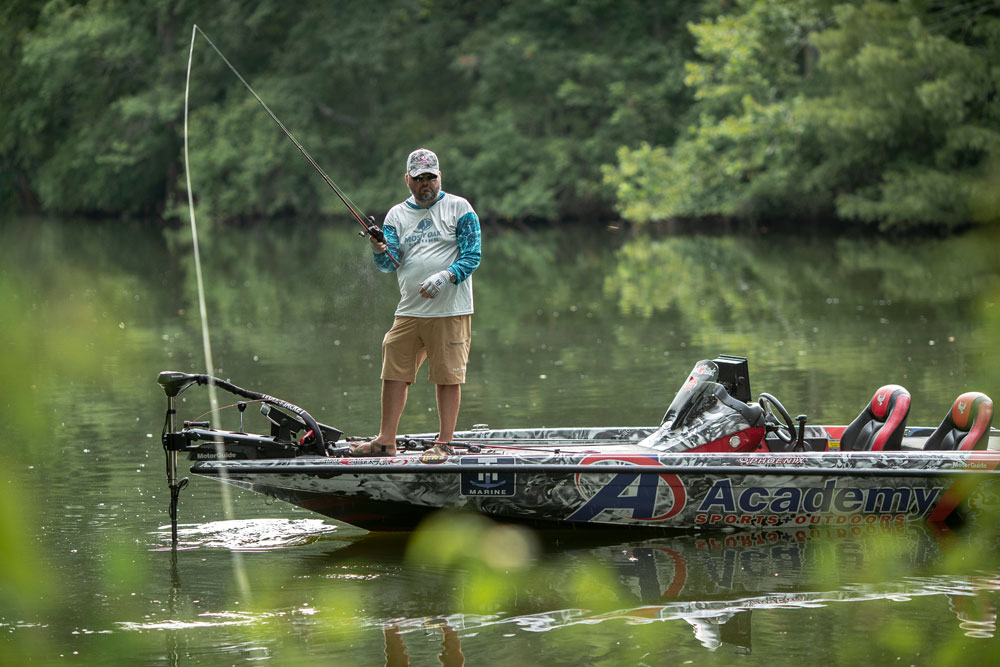with Greg Hackney
Mossy Oak Fishing Pro Greg Hackney won second place at the Major League Fishing Redcrest Tournament on the Mississippi River, ending on August 25, with 22 bass weighing 40 pounds, 7 ounces. Here’s how Greg selects which line to fish.

The type of line and the correct pound test of line are critical components in catching bass with certain kinds of lures. The main thing I consider when picking a line size I want to tie my lure to is determining what line size will give me the most natural action on that type of lure. That’s why when I’m fishing a drop-shot rig or a shaky head, I never use a line size larger than 8-pound test – no matter whether the water is dirty or clear. The reason for my choosing that 8-pound line is because heavier line won’t give me the best action from the lure.
However, if I’m casting a 1-ounce jig, I’ll use 20-pound-test line. A 1-ounce jig will perform just as well on 20-pound-test line as it will on 10-pound. So, I don’t select my line size on water color or water clarity but rather solely on the action I can give the bait to make it look the most natural. I believe that if I’m fishing the best line size for the right lure, the bass doesn’t pay any attention to the line size. Instead the bass is focusing all its attention on the lure. Oftentimes, I think that anglers pay more attention to the diameter of the line than the bass do. If you’ve got the right line size to get natural action from your lure, then I don’t believe line size matters. If I’m throwing a big, shallow-running crankbait, I can get just as much action on that lure if I’m using 20-pound-test line as I will fishing 10-pound-test line.
How Hackney Chooses Between Monofilament, Braid or Fluorocarbon Line
Which type of material your fishing line is made of is often the angler’s preference. But the way I decide between these three materials from which line is made depends on the tactic I’m using. For instance, if I’m flipping and need to go to a line size bigger than 20-pound-test fluorocarbon, I’ll fish braided line. Most professional anglers today use very little monofilament line. About the only time I’ll choose monofilament to fish for bass is if I’m fishing a spinner bait or a bladed jig or cranking very heavy wood with a square-billed crankbait and making short casts. A crankbait doesn’t get hung-up as much in heavy wood with monofilament line as it does with other kinds of line.
When I’m fishing line from 6-20 pound test, 90% of the time I’ll be using fluorocarbon since that line is denser, has less stretch and is more sensitive than monofilament. Fluorocarbon does cost much more than monofilament does. Two-hundred yards of monofilament probably will cost $3 or so. A 200-yard spool of premium fluorocarbon will cost about $40. That’s one reason that many bass anglers still fish with monofilament rather than using fluorocarbon line. Today monofilament line is as cheap as it’s ever been, since I’ve been bass fishing, although monofilament is better now than it ever has been. You may pay $5 - $6 for 600 yards of premium monofilament. However, 500-600 yards of fluorocarbon may cost $100.
How to Decide to Fish Fluorocarbon or Braided Line
I swim a jig, fish a rubber frog and often flip with braided line. If I’m fishing with a spinning rod, I’ll typically use braided line from 6-10-pound test as my main line and tie on a fluorocarbon leader. I know that any time I’m flipping heavy cover or vegetation, I’ll fish with braided line. If I’m fishing deep grass, I’ll use braided line. Too, if I’m swimming a jig, I’ll use braided line. When I’m short-casting a spinner bait, a bladed jig or a crankbait, I’ll fish with monofilament. I also use monofilament when I’m fishing top-water lures like a popping bait or a prop bait.
I’m not saying that monofilament is a bad line to use because I’ve caught plenty of bass on monofilament before fluorocarbon line ever was invented. However, fluorocarbon does have advantages in specific situations that monofilament doesn’t have. Fluorocarbon is more difficult to cast than monofilament, since it’s a stiffer line. But fluorocarbon has so many more advantages than monofilament that most tournament anglers are fishing more fluorocarbon in more situations than they are monofilament.
So, I think the biggest deterrent for most anglers is the high cost of fluorocarbon as compared to the same amount of monofilament. We could talk about line all day, but these are the basic reasons I use the line I use with the lures and in the situations I fish.






























